Masterworks Review 2024: Andy Warhol in Your Investment Portfolio?
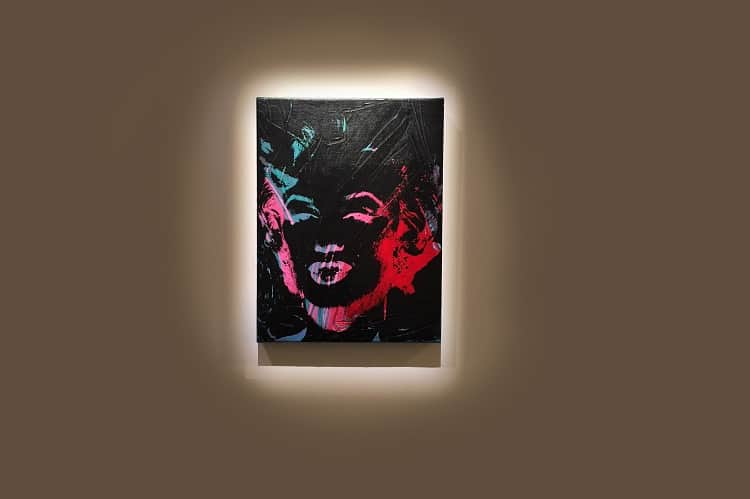
This Masterworks review was updated on 01/01/2024.
Part of what I love about being a money blogger is learning about innovative startups and investment platforms. Last year, I came across one that was particularly interesting and mentioned it in a post about alternative investment ideas.
Today I’m digging deeper into Masterworks, an investment platform that enables investors to profit from “blue-chip” fine art with as little as $1,000.
This investment strategy is totally legitimate, made possible because of the JOBS Act of 2012, also known as the crowdfunding act.
Before you jump on board, realize that while the SEC qualifies each opportunity, crowdfunded investing in art is still new.
Though it seems to be on track to work as intended, no other company has ever attempted this before. As with all investments, there are risks you should understand before committing any money.
Please note: This article is not a recommendation to buy or sell paintings on Masterworks, or fine art in general. Determine on your own if this asset class is right for your investment objectives.
Table of Contents
How Masterworks Works
Masterworks has built a first-of-its-kind online platform that enables investors to buy shares in fine art, much like you buy shares in a company or real estate property.
Masterworks does most of the heavy lifting, including the painting selection, acquisition, storage, insurance, market analysis, and sale facilitation. Investors choose which available paintings they wish to invest in, then sit back and wait for the price to appreciate. When Masterworks receives an offer to purchase the painting from an outside collector, shareowners vote to sell or hold.
Here is the expected life-cycle of a single painting.
Step 1: Masterworks buys a painting
A team of experienced art collectors (Masterworks employees) analyzes sales data and market trends to identify pieces of art that are expected to appreciate over time.
Then, representatives from the company then attempt to purchase the identified paintings at auction. When a painting is secured, the company pays the seller and acquires the artwork using company funds.
The artwork is stored securely and insured for it’s appraised value.
Step 2: Masterworks files an offering circular with the SEC and takes the painting public
The next step is to file an offering circular with the SEC. Filing an SEC document is a tedious process which requires significant cost and effort to complete. The offering circular is required to make the painting investable by the crowd. Once the offering is qualified, shares are sold to investors.
The filing and qualification process took about 18 months to complete for the first painting. But now that the first one is complete, future qualifications are expected to take a few weeks to a few months or more.
The offering circular defines a separate business entity for each painting (e.g., Masterworks 001, LLC will own the Warhol painting). It then lays out the cost to acquire the painting, price per share, minimum investment amount, and several risk factors, similar to real estate crowdfunding circulars and IPO filings.
Step 3: Masterworks sells shares to investors (via broker-dealer)
Once the offering is qualified by the SEC, a registered broker-dealer sells shares of the painting to investors. The initial share price and minimum investments may vary per painting. For the Andy Warhol piece, shares are priced at $20 with a 50 share minimum investment.
Investors become shareholders in the LLC. The LLC owns the painting.
Step 4: Masterworks monitors the investment
The Masterworks team then tracks the sales of similar Warhol paintings sold at auction to estimate the current value of the qualified investment. They keep investors informed with exclusive market insights.
The company aims to become a leader in market data for blue-chip fine art.
Step 5: Investors vote to sell or hold upon outside offers
The expected investment horizon for each painting is three to ten years. The timeline is heavily dependent upon the marketplace and the will of the investors who own the painting.
When an outside investor offers to buy a painting, investors vote to sell or hold the painting — majority rule.
If investors vote to sell, the ownership transfers to the collector and investors receive the proceeds from the sale, minus any costs outlined in the offering circular. Masterworks takes 20% of the profits. Appreciation is the primary way the company expects to make money.
Masterworks Review: Why Invest in Fine Art?
Fine art has long been a reliable, appreciating asset over time. But the cost to acquire valuable pieces of artwork is prohibitive for most of us, even if you understand art. Masterworks now makes investing in blue-chip possible for everyone.
Here area few reasons to consider investing in fine art:
- Diversification
- Excellent returns
- Price stability
Diversification
The primary attraction to alternative investments is diversification beyond stocks, bonds, and cash. Wealthy investors turn to fine art to diversify their assets to grow and preserve wealth. Alternative investments do not fluctuate as much as liquid market-traded assets such as stocks and bonds.
Fine art is a market commodity. However, trends and prices are more nuanced because the value placed on art is subjective compared to traditional investment assets. As such, the value of fine art is non-correlated to stocks, though, during stock market downturns and recessions, demand can subside.
A survey conducted by Deloitte found that 88% of wealth managers say that art and collectibles should be included as part of a wealth management strategy.
Excellent returns
A fancy art collection may seem like a game for billionaires who want to impress their friends, but the return on investment has been solid over the years. According to the ArtPrice100®, an artist-weighted index that tracks artwork prices of the top 100 blue-chip artists, the index outperformed the S&P 500 index since January 2000. 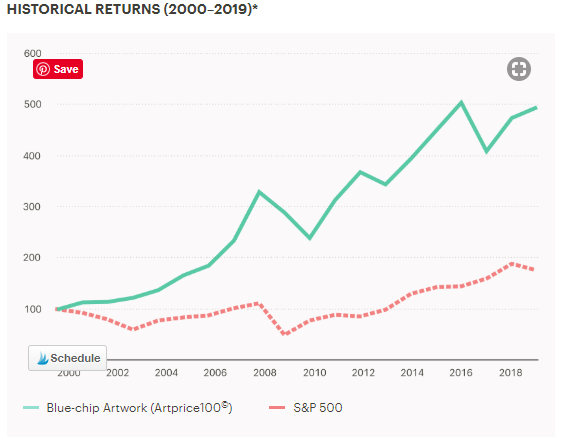
Source: The Artprice100® Index Base 100 on January 1st, 2000
Price Stability
Fine art can be a way to grow and preserve wealth, but with far less price fluctuation. There may be some price movements that track the performance of the markets or economy, but as indicated in the chart below, art prices are stable relative to the stock market.
Example: The Andy Warhol Painting of Marilyn Monroe
Masterworks paid $1,815,000 for the Andy Warhol painting titled, 1 Colored Marilyn (Reversal Series), 1979, Oil and silkscreen inks on canvas at a Phillips auction in New York on November 16th, 2017.
Here’s how Phillips describes the painting:
the iconic features of Marilyn Monroe are expressed in negative, with gestural swirls of turquoise, hot pink and cadmium red, coalescing under the inky depths of a strong black screen with palpable intensity.
Here’s market data of similar Warhol paintings that have sold since 1990. Masterworks uses data to identify investments for its offerings.
As indicated in the offering circular, Masterworks intends to raise $1,996,500, which is 10% above the purchase price. The extra 10% is meant to “true-up” the value of the painting, or, appreciate the estimated value since it took 18 months to qualify the investment.
The law allows for the company to raise up to $50 million for any single offering.
Paintings owned by Masterworks investors are required to be independently appraised on an annual basis to maintain adequate insurance coverage.
Example: Claude Monet’s Coup de Vent
Masterworks purchased a second painting in June 2018, Claude Monet’s Coup de Vent. The company paid $6,239,556 and is in the process of qualifying the painting for investment (Masterworks 002, LLC, offering statement).
Other Considerations About Investing with Masterworks
What are the Risks?
The offering circular discloses several risks for investors to consider before investing. Reading through the risks can be scary, but companies write up every thinkable scenario in the risks section so that investors are informed.
Some of the risks to pay attention to include:
- The company is a startup, and the business model is untested
- The company is undiversified since there is only one investment so far
- Costs will lower investor returns
- Art is not guaranteed to appreciate
- Painting values are highly subjective until a sale is made
- Ownership of Warhol’s work is highly concentrated
- Physical risks to the painting (damage, theft, etc.)
- Post-mortem damage to the artist’s reputation
- Risk of non-compliance with regulators
Masterworks is a startup and operates from venture capital and founder funding. As such, it could run out of money and fold. The business model relies on capital appreciation of artworks over time for it to thrive. If investors vote to hold a painting, there may be an operating cash pinch.
Appreciation of any piece of art is not guaranteed.
On the plus side, each investment is set up as a separate entity. If the parent company were to dissolve, the separate LLCs would continue to carry out the investment or attempt to liquidate. The painting itself secures the investment.
In other words, if Masterworks were to follow the fate of RealtyShares (which folded) it would continue to operate the individual LLCs, or pass them on to a third party that would operate under the 1.5% management fee.
Who can Invest with Masterworks?
Accredited (~millionaires) and non-accredited (~<millionaires) investors can invest with Masterworks. The only restriction for non-accredited investors is they may only invest funds which do not exceed 10% of the greater of the purchaser’s annual income or net worth (here’s how to calculate net worth).
Masterworks Review 2024: Taxation
Masterworks creates a separate LLC for each painting. Investors become shareholders in the partnership. This is already common in the real estate crowdfunding space, and Masterworks is following the lead.
An LLC is created to limit the liability of the entity, which is good. However, when you are a part owner in a partnership, you will receive a Schedule K-1 at tax time. K-1’s complicate your tax return and often aren’t ready until after the April 15th filing deadline, requiring you to file an extension or amended tax return.
From the offering circular:
The company will file a U.S. federal partnership information return reporting its operations for each year and provide a U.S. Internal Revenue Service Schedule K-1 to each holder. However, holders may not receive such Schedule prior to when their tax return reporting obligations become due and may need to file for extensions or file based on estimates.
The company highly recommend that you contact a tax professional to understand the consequences of investing on the Masterworks platform.
Dividends
Masterworks does not pay a dividend to shareholders. There is no income generated until the painting is sold.
Liquidity
Investments made through Masterworks are illiquid, meaning you cannot readily sell your shares and receive your money back, like a stock. Shares do not trade on an exchange.
You must abide by the investment terms, which is to hold the painting until shareholders vote to sell upon an offer.
In the future, Masterworks intends to create a marketplace upon which investors can buy and sell shares of paintings, but this is not possible yet. Before then, the company is considering an annual liquidity window.
Fees
Filing SEC documents isn’t cheap, and the founders of the company are in this for profit. So how to Masterworks charges fees and make money?
Masterworks charges a 1.5% administrative/management fee per year on all Class A shares (regular shareholders). Also, Masterworks retains ownership of 24,956 Class B shares, or a 20% “profits interest.”
The fee structure is similar to the hedge fund industry, which is notorious for its 2% and 20% fee structure. Masterworks is slightly better at 150 basis points for the administrative fees.
The fees are high compared to other crowdfunding sites and alternative asset classes. However, the 20% profit fee is an incentive to select paintings that appreciate over time, which aligns with the best interests of shareholders.
Masterworks Review: The Company
Masterworks is a New York City-based startup founded in 2017 by Scott Lynn, an entrepreneur who made his name in online advertising. He’s been a collector of fine art for the past 15 years.
Members of the Board of Directions include Eli Broverman who co-founded Betterment, Dan Miller who co-founded Fundrise, and Michael Moses who co-created the Mei Moses Art Indices.
Venture capital funding details are not available, but the company lists Loupventures as an early investor. Scott Lynn is also a primary investor.
Conclusion – Masterworks Review 2024
This idea of taking a piece of art and splitting it among several investors to legally share ownership and spread risk is intriguing. But cool doesn’t mean it’s a good investment or right for your portfolio. If you are considering investing on the Masterworks platform, please use a small amount of speculative money.
Thoroughly read through the offering circular to fully understand the risks, fees, and how the whole thing works.
I seriously considered a $1,000 investment out of curiosity and a fondness for the artist with whom I share a home town. But I decided against investing to avoid further complicating my financial situation because of the partnership structure and associated K-1 required for tax filing purposes.
If you use a CPA to file taxes and aren’t scared off by the K-1, then this may be an interesting opportunity. Blue-chip art returns seem to be solid compared to traditional investments. However, the market for fine art still fluctuates. And you’re still reliant upon other people to select the investments for you, a service you’ll need unless you understand the marketplace.
Disclosure: RBD is an affiliate partner with Masterworks, but opinions are my own. If you submit information via any link on this page, RBD may be compensated at no additional cost to you. Read the full disclosure here. Thanks for reading this Masterworks review 2024.
Photos and graphics via Masterworks

Craig is a former IT professional who left his 19-year career to be a full-time finance writer. A DIY investor since 1995, he started Retire Before Dad in 2013 as a creative outlet to share his investment portfolios. Craig studied Finance at Michigan State University and lives in Northern Virginia with his wife and three children. Read more.
Favorite tools and investment services right now:
Sure Dividend — A reliable stock newsletter for DIY retirement investors. (review)
Fundrise — Simple real estate and venture capital investing for as little as $10. (review)
NewRetirement — Spreadsheets are insufficient. Get serious about planning for retirement. (review)
M1 Finance — A top online broker for long-term investors and dividend reinvestment. (review)

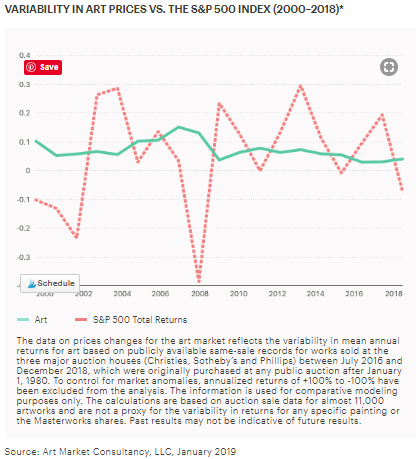
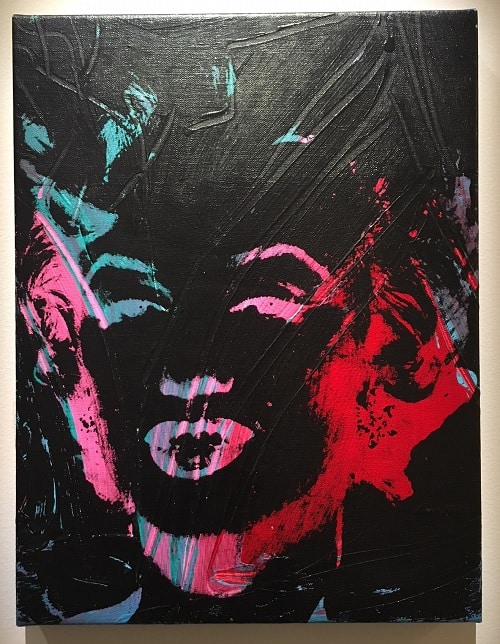
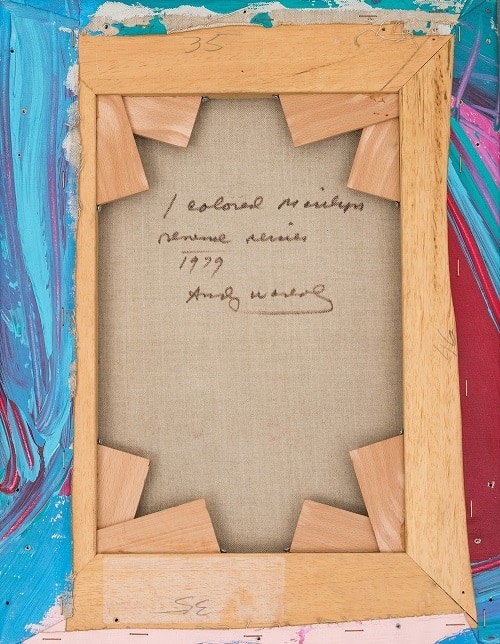
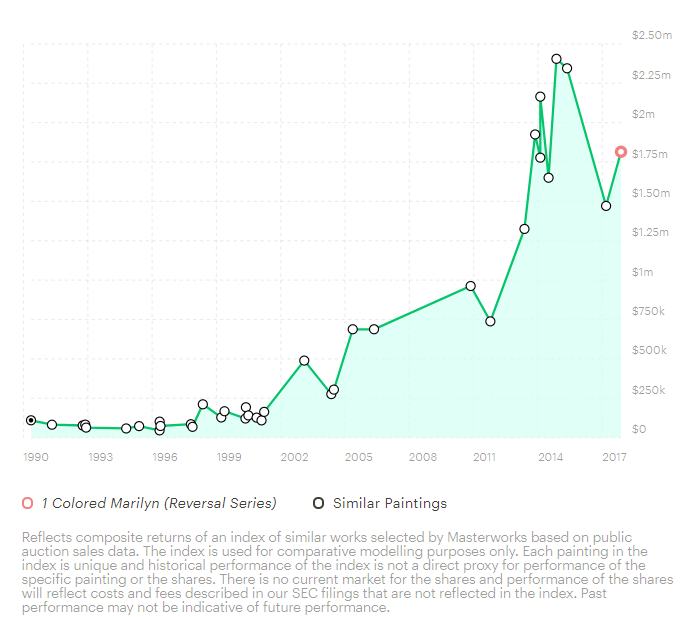
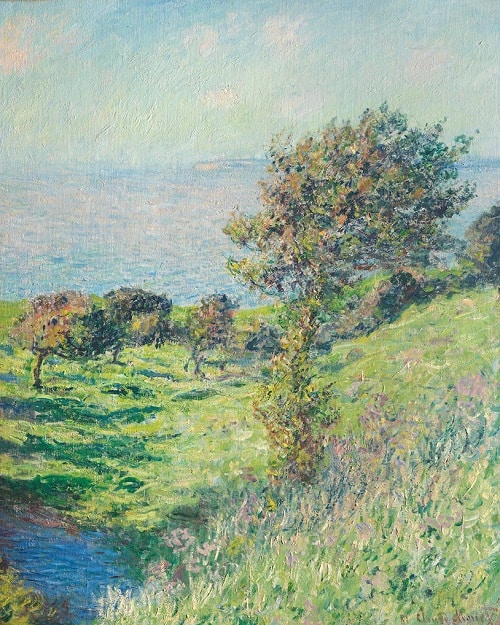
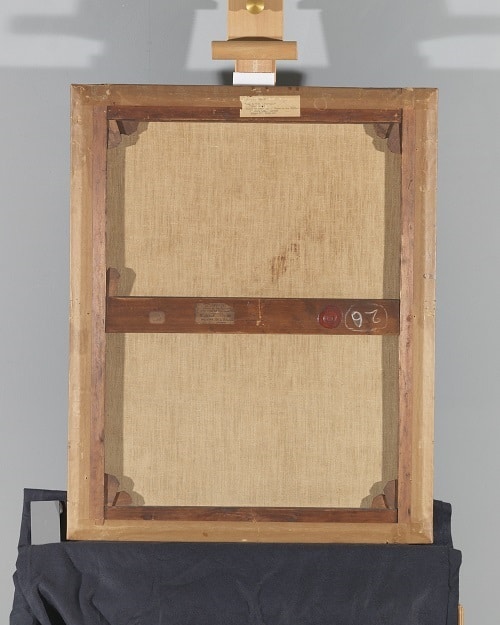
Thanks for well written and informative post. This is the first I have heard of this. I recall reading an article by Jim Rickards that talked about a survey of families that maintained their wealth for more than 500 years. They found that they had about 1/3 Fine Art, 1/3 Gold and 1/3 Land. Art has never really been accessible to the peasants.
Thanks for the overview of Masterworks. I only recently heard of it so this is very timely. For an art lover, this sounds like a way of using some excess investment money to combine passion and finances, but I’m still not sold on art (or any collectible), especially going into a recession. I’ll stick to the must-haves till I’m confident we’re firmly out of bear territory.